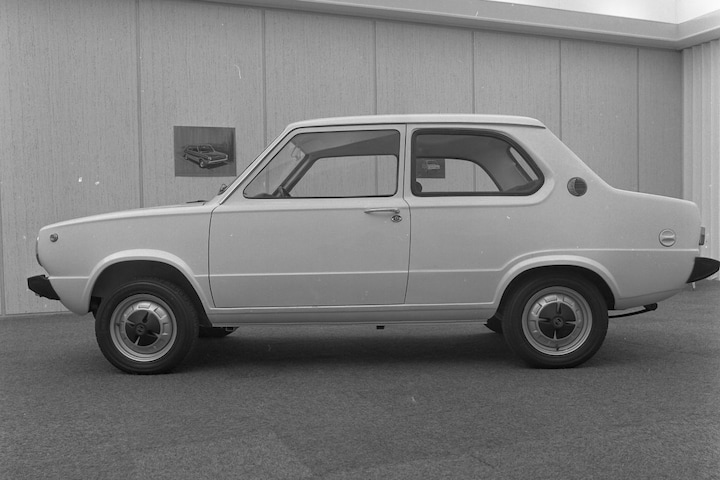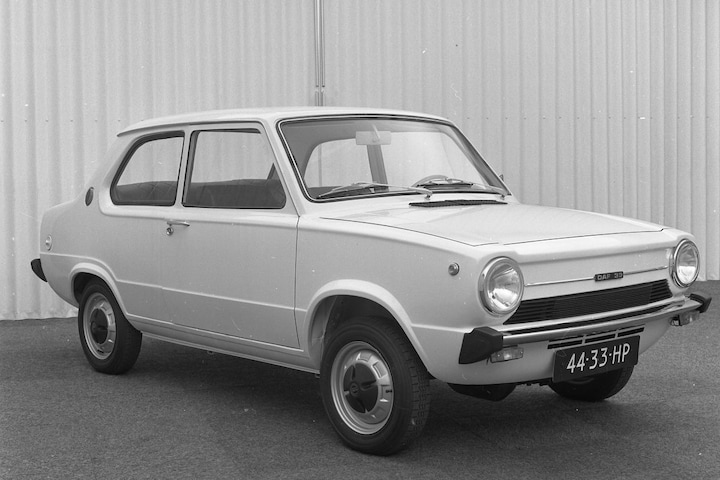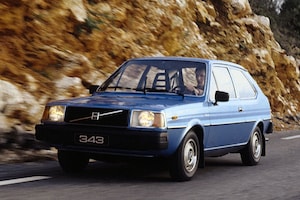P200, P300 and P500
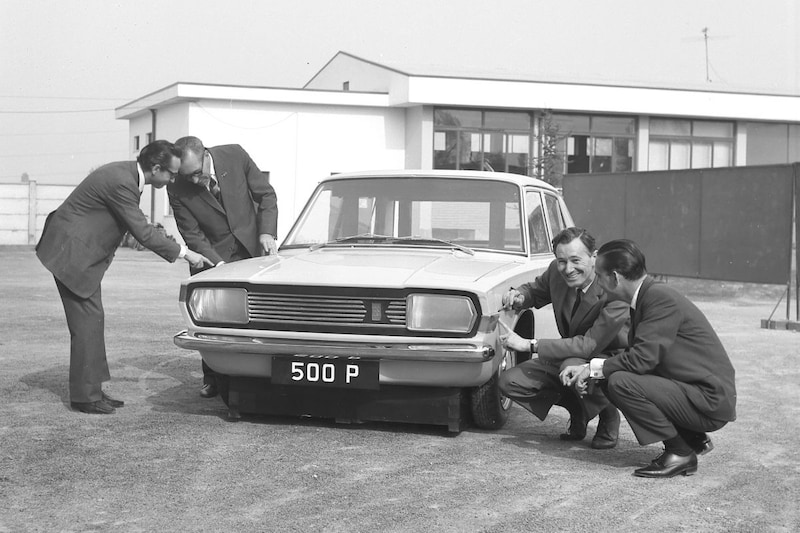
At DAF they had big plans in the mid-1960s with both small and larger models. Although those cars never found their way to the showroom, silent witnesses to the drive for innovation in the DAF Museum show that the plans – ambitious or not – were quite serious.
The top floor of the DAF Museum is full of cars that have dominated the street scene for years in a colorful palette. However, among the regular models there are also a number of exotics, two of which look remarkably inconspicuous. You could just pass it by, because their lines are neatly in line with the design language that characterized other Dafs in the late 1960s. It is the style of master stylist Michelotti at its finest. We are talking about a compact, green model and a fairly large white one. They indicate their number plates with their respective project numbers P300 and P500.

The Daf P300 and P500 on the top floor of the museum in Eindhoven. (photo Maurice Volmeyer)
Curious about where we should place these cars in the history of DAF, we go to the museum’s archive. There we talk to Ad van Gerwen (1943), at the time at DAF (and ultimately NedCar with the Volvos and Mitsubishis) responsible for the construction of prototypes. At least, of the passenger cars. “Trucks? I don’t understand that, and I don’t want that either,” says Ad. The standard work by Joan van der Brugghen – at the time the right-hand man of the Hub brothers and Wim van Doorne – from 1988 also provides the necessary starting points to put the puzzle around the two prototypes.
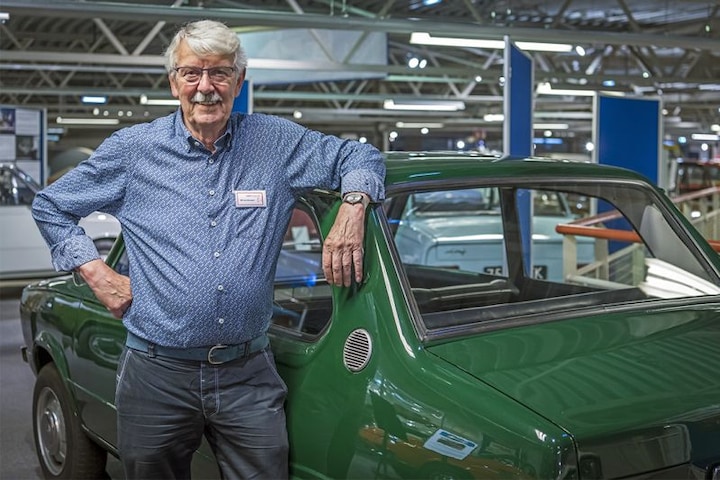
Ad van Gerwen. (photo Maurice Volmeyer)
Higher with the P200
In the early 1960s, DAF had the idea of expanding the range further. That idea became concrete in 1965 with project P200, which involved the development of a larger model than the B-body (for the Daf 44), which had not yet been presented; master stylist Giovanni Michelotti is currently putting the finishing touches to it in his studios in Turin. Michelotti is also responsible for the exterior design of the P200, including a full-size wooden model. Under the hood will be an in-house 1.8- or 2.0-liter four-cylinder in-line engine that has yet to be developed. Not in combination with DAF’s characteristic Variomatic, but with a conventional three-speed automatic transmission from BorgWarner, the BW-35. The latter aspect immediately gives an idea of where we should place the new large Daf; the BW-35 can also be found in large cars such as the Citroën DS and various Jaguars, Rovers and Volvos.

Daf P200, already equipped with 77 badges.
The photo suggests that the P200 is even larger than BMW’s Neue Klasse (in which Michelotti was also involved). To indicate its place in the hierarchy above 33, 44 and 55, the makers already provide the wooden model with 77 badges. This type number would later be used for the P900, which would eventually be marketed as the Volvo 343. They seem serious in Eindhoven. Well, for a while, because before the project could get serious, it was Wim van Doorne himself who canceled it in March 1967. From Van der Brugghen’s work we conclude that the car would slow down the sales growth of the existing range.
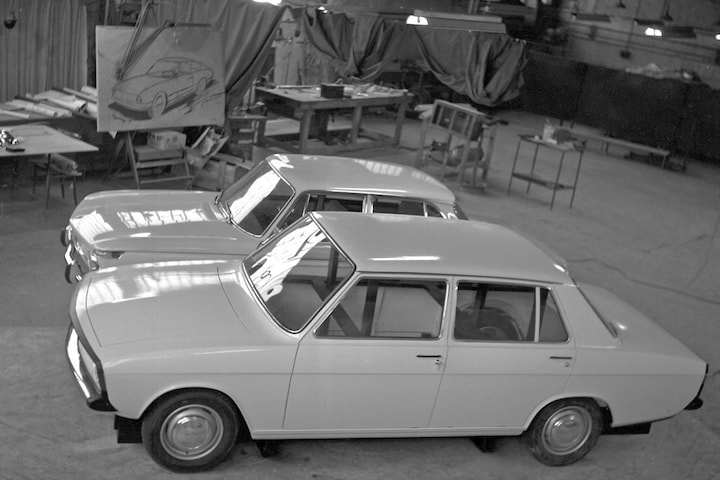
The P200 looks larger than BMW’s Neue Klasse; Michelotti also had a hand in its design.
P300 is a precursor to compact Daf
With the end of the P200, more time is freed up for another project: the P300. In contrast to the large P200, this is a compact car, replacing the A-body models, which are getting older. Van der Brugghen reports that the little one should be in the showroom at the end of 1971. In order to position it more clearly under the 44, the P300 must become more compact than the A-body. They once again turned to Michelotti in Eindhoven to draw the bodywork. It is therefore not surprising that the P300 shares the necessary styling elements with the brand new Daf 44.
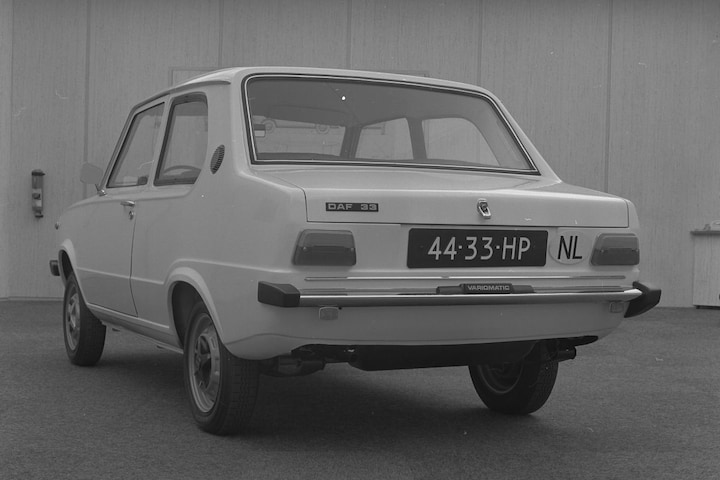
The Daf P300 must be fifteen centimeters shorter than the Daf 33.
Completely in line with DAF tradition, Michelotti must design a sedan, although there are also drawings of a model with a sloping rear – à la Fiat 127 – with hinges on the roof, which reveal that a three-door hatchback was being considered. However, resistance to such a bodywork was great at DAF in those years. To make the trunk of the new sedan sufficiently accessible, Michelotti comes with a rear window that is steeper than the rear edge of the C-pillars. This is a trick that Jaguar would use to a superlative degree years later with the XJ-S. The trick with a less sloping rear window was born out of necessity, because the P300 must be fifteen centimeters shorter than the Daf 33, while the wheelbase is actually five centimeters longer for the sake of interior space. In the wind tunnel, a full-size wooden model appears to have a Cd value of 0.38, which, given the knowledge at the time, is an excellent value for a compact car.
Borrowed technology will power P300
To secure the future, DAF has been looking for cooperation in those years. It looks around broadly. Exploratory discussions are taking place with BMW, Chrysler (Rootes), Ford, General Motors, Nissan, Peugeot and Volvo. But it is not yet very concrete and that also applies to the technology of the small P300. Although DAF has its own two-cylinder boxer engine, it is not a foregone conclusion whether it will also be used in the P300. Initially, the 848-cc four-cylinder from the Mini from Austin and Morris is being considered; DAF can produce that inline engine under license. In itself it is an obvious choice; For trucks, DAF built Leyland’s large truck diesels under license from 1957 to 1968. And both Austin and Morris, like Leyland Motors, have been under the British Leyland umbrella since 1968.
Another line runs to Renault. The 956-cc version of the Cléon-Fonte engine from the R4 is also an option for the P300. DAF will use the 1,108 and 1,289-cc versions of that engine for years in the 55 and 66 and with the Volvo 343 it starts with the 1,397-cc variant. There is more clarity about the rest of the drivetrain, at least for the version with automatic transmission: that will be the Variomatic. In the event of a possible collaboration with General Motors, the construction of a P300 with a manual gearbox at GM in Antwerp is conceivable.
The two steel prototypes that saw the light in early 1970 both received the 844-cc boxer from the DAF 44, just like its Variomatic with two belts. Consideration was given to giving the car a Variomatic variant with one belt, but they did not dare to do that yet; the 46 will get that four years later. However, unlike the 44, the P300 does not have a swing axle construction at the rear, but a De Dion axle. The suspension with swing axles fell into disfavor in those days. The mediocre handling attributed to that construction is no longer acceptable and partly due to the 1965 book ‘Unsafe at any speed’ by the American Ralph Nader, the car industry is en masse looking for alternatives. This also applies to DAF, hence a De Dion axle.
In 1970, plug out of plug from project P300
In order not to stand out too much, DAF has the test drives mainly carried out at night, with the then not yet opened A67 highway between Eindhoven and Venlo as its favorite location. With the 44’s drivetrain on board, it is not surprising that the performance of the P300 is at the same level as that of its big brother, four years older. Unfortunately, the same applies to the costs. In order to be able to charge a healthy margin, it is virtually impossible to keep the price of the P300 – already equipped with 33 badges – below that of 44. Despite four years of work and a significant expense, the high cost was reason enough for the DAF management to pull the plug on project P300 in October 1970.
After P200 first P400
Although the large P200 was discontinued in March 1967, the desire for a larger size has not disappeared. The trash bin in which the P200 disappears has barely been emptied when Michelotti is commissioned to draw a four-door car with 1,300 and 1,500 cc four-cylinders: project P400. Now not with a BorgWarner automatic transmission, but with DAF’s Variomatic and a De Dion rear axle. Van der Brugghen writes that when he came face to face with a full-size wooden model of the P400 in Turin in June 1967, he was shocked to find that the car did not differ enough from the Dafs 44 and 55, so that he could not do anything. otherwise the rest is to reject it. They didn’t worry about it for long and a few months later project P500 started, now for a car that clearly had to be bigger than the P400 again. A lot of work is being done: in February 1968, a first full-size wooden model was presented to the DAF management for assessment, followed in November by a driving prototype.

Daf P500
DAF does not yet have its own technology for a car of that size. This means that the prototype will have the four-cylinder from the Simca 1500, as well as a four-speed manual gearbox from Ford and a rigid rear axle from Vauxhall. Ultimately, the P500 is planned to get the 1,289-cc variant of the Renault engine from the 55 and a De Dion rear axle. However, it will never get to that point, because the P500 will be discontinued before the end of 1969. The management comes to the conclusion that DAF, as a manufacturer of compact cars, should not embark on an adventure with large, prestigious models. The shoemaker sticks to his last. Van der Brugghen writes: ‘In general, large, exclusive or prestige automobiles from those brands that are generally known for their popular models will not be able to compete with the ‘big brands’ such as Mercedes, Jaguar and the like that are never sold in large numbers. sees.’ According to him, large cars should preferably carry a different brand name than small models. So no Opel Senator next to a Kadett and no Fiat 130 next to a 128, but within one group a Jaguar next to a Mini or a Volkswagen Golf next to an Audi 100. Because just look: large models from Austin and Volkswagen, such as the Austin 1800 and the Volkswagen K70, came to nothing.
Later 300 series benefits from projects
Van der Brugghen does not see the premature cancellation of already well-developed projects as insurmountable. At DAF, three major projects fail, two of which are within sight of the finish line: the small P300 and the large P200/P500. The mid-range P400 gets stuck at an earlier stage. This is offset by just as many successful projects: the A-body, the B-body and (although under the Volvo flag) the 343, which amounts to a score of fifty percent. According to Van der Brugghen, this was not unusual in the car industry at that time. In fact, at Citroën, British Leyland and Volkswagen, for example, the waste percentage is significantly higher during that time. Fortunately, the work on the small P300 and the large P500 was not entirely in vain. Although they were sold as complete cars, they continued to operate technically and the De Dion axle in combination with the Variomatic was further developed for the facelift of the Daf 55, which was launched on the market in 1972 as the Daf 66. The axle is also used in the P900, which we eventually get to know as the Volvo 343. And the Daf 46 also gets the De Dion construction, only with a single-belt Variomatic. As silent witnesses to progress, the P300 and P500 are neatly lined up in the DAF Museum. For those who want to see them: pay close attention, because before you know it you will pass them by.
– Thanks for information from Autoweek.nl
